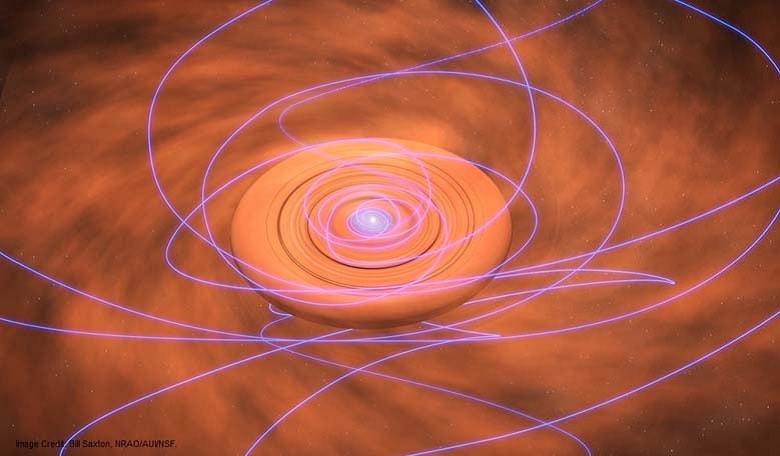Scientists studying a young protostar about 750 light-years from Earth in the constellation Perseus, have found that material in the disk surrounding the star could have dragged in and twisted magnetic fields from the larger surrounding area, thus providing clues as to how disks channel raw material onto the growing star.
Using the National Science Foundation's Karl G. Jansky Very Large Array (VLA) radio telescope to produce images with unprecedented detail, a team of researchers have measured the polarisation (alignment) of radio waves, emitted by the dusty material, to reveal the configuration of magnetic fields in this region near a young star dubbed NGC1333 IRAS 4A. It is thought that as material from the envelope of dust and gas surrounding the protostar falls inward toward the rotating disk, it has dragged magnetic field lines in with it, thus altering the structure of the magnetic field from a circular morphology near the star compared with the hourglass morphology seen on larger scales.
"Our VLA observations are showing us this region, where the change in shape of the magnetic field is taking place," said Erin Cox, a researcher at the University of Illinois Urbana-Champaign and lead author of a paper submitted recently to the Astrophysical Journal Letters. These morphologies that show frozen-in field lines are consistent with the field being dragged in by rotating material entering the infall region of a disk and it is also the first polarisation detection of a protostar at these wavelengths (8 and 10 millimetres).
The process of star formation is a key phenomenon in astrophysics, however despite the fundamental nature of this process, it still remains poorly understood. It is thought that magnetism plays a key role in star formation from regulating disk accretion, outflows to wind launching, but to what degree these mechanisms play a part is still debated. "The alignment of magnetic fields in this region near young stars is very important to the development of the disks that orbit them. Depending on its alignment, the magnetic field can either hinder the growth of the disk or help funnel material onto the disk, allowing it to grow," said Leslie Looney, of the University of Illinois at Urbana-Champaign and a co-author of the paper.
This system containing NGC1333 IRAS 4A is actually made up of two protostars in a circumbinary envelope that contains material with a total mass more than twice that of our Sun. Observations of the protostar and its envelope also indicate that numerous particles, from millimetre to centimetresized, are present in the disk. Since the young star is only about 10,000 years old – a baby in astronomical timescales – it could be an indication that grains form and grow quickly in the environment of a still-forming star: another process which is still unresolved and hence heavily debated by researchers in the field of star formation.











